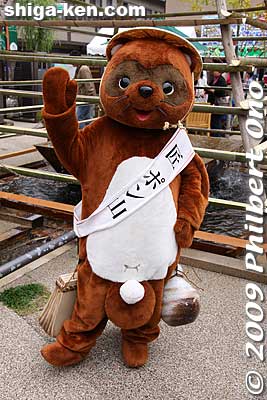Koka, Shiga
| Koka, Shiga (甲賀市; Kōka-shi) | ||
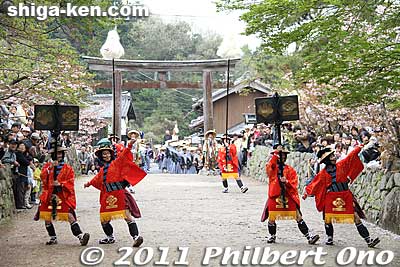 Aburahi Matsuri Yakko-furi. More Koka photos here. Aburahi Matsuri Yakko-furi. More Koka photos here.
| ||

| ||
| Location | Shiga Prefecture, Kinki region, Honshu island, JAPAN | |
| Population | 91,068 (2,189 foreigners) (2014-06-01) | |
| Area | 481.69 km² | |
| City Centers | Minakuchi, Shigaraki | |
| Major Sights | Minakuchi Castle, Ninja Village, Shigaraki Ceramic Park | |
| Major Gateways | JR Kusatsu Line Kibukawa Station, Koka Station; Ohmi Railways Minakuchi Jonan Station; Shigaraki Kogen Railway Shigaraki Station | |
| Train Stations | JR Kusatsu Line Kibukawa Station, Konan Station, Terasho Station, Koka Station, Aburahi Station; Ohmi Railways Minakuchi Matsuo Station, Minakuchi Station, Minakuchi Ishibashi Station, Minakuchi Jonan Station, Kibukawa Station; Shigaraki Kogen Railway Kibukawa Station, Shigarakigushi Station, Kumoi Station, Chikushi Station, Gyokukeiji-mae Station, Shigaraki Station | |
| Claim to Fame | Home of ninja | |
| Products | ||
| Neighbors | Otsu, Ritto, Konan, Ryuo-cho, Hino-cho, HigashiOmi | |
| Old Name(s) | Kouka-cho (Koka-cho), Kounan-cho (Konan-cho), Minakuchi-cho, Tsuchiyama-cho, Shigaraki-cho | |
| Keywords | Koga ninja, Tokaido shukuba | |
| Historical Persons | ||
| Links | Koka Articles | Koka Photos | |
| Koka Tourist Information | ||
| Location | City Hall | |
| Phone | 0748-65-0707 | |
| Tourist Links | Koka Info | |
| Int'l Association | Web site Tel: 0748-63-8728 | |
| Volunteer Guides | Tel: Shigaraki 0748-82-8075, Minakuchi 0748-62-1621 | |
| Koka City Hall 甲賀市役所 | ||
| Address | Koka City Hall, Minakuchi Branch, Minakuchi-cho, Minakuchi 6053, Koka, Shiga 528-8502 甲賀市水口町水口6053
Koka City Hall, Kounan Branch, Kounan-cho, Noda 810, Koka, Shiga 甲賀市甲南町野田810 Koka City Hall, Tsuchiyama Branch, Tsuchiyama-cho, Kita-Tsuchiyama 1715, Koka, Shiga 甲賀市土山町北土山1715 Koka City Hall, Koka Branch, Koka-cho, Sagami 173-1, Koka, Shiga 甲賀市甲賀町相模173-1 Koka City Hall, Shigaraki Branch, Shigaraki-cho, Nagano 1203, Koka, Shiga 甲賀市信楽町長野1203 | |
| Phone/Fax | Minakuchi Branch: 0748-65-0650
Kounan Branch: 0748-86-4161 Tsuchiyama Branch: 0748-66-1101 Koka Branch: 0748-88-4101 Shigaraki Branch: 0748-82-1121 | |
| Official Site | Japanese | | |
| Symbols | Flower: | Sasayuri lily (Lilium japonicum) |
| Tree: | Cryptomeria | |
| Bird: | Common Kingfisher | |
| Others: | Ninja | |
| Logo: | 
| |
| Sister Cities | Traverse City, Michigan; Marshall, Michigan; Dewitt, Michigan; Icheon Kyonggi-do, Republic of Korea | |
This page is 75% complete. Last updated: July 4, 2014
by Philbert Ono
Koka (甲賀市; -shi) is a landlocked city in southeastern Shiga Prefecture, on the border with Mie Prefecture.
Home of the Koga ninja (actually pronounced "Koka") and Shiga's second largest city in area, Koka was formed in Oct. 2004 with the merger of Koka, Minakuchi, Shigaraki, Tsuchiyama, and Konan towns. These former towns are distinct geographical, cultural, and historical areas each having its unique attractions.
Although it does not face Lake Biwa, the city is spread far and wide with diverse sights such as Shigaraki pottery, Ninja houses, Minakuchi Castle, major festivals, and Tokaido Road post towns Minakuchi-juku and Tsuchiyama-juku.
The JR Kusatsu Line and Ohmi Railways are the main ways to reach Koka.
Sights

| 
| 
|
| Shigaraki | Koka Ninja House | Minakuchi-juku and Castle |

| 
| 
|
| Minakuchi Hikiyama Matsuri | Koka Ninja Village | Tsuchiyama-juku |
- Koga-ryu Ninjutsu House 甲賀流忍術屋敷 - Koka has a ninja house open to the public. This one is more authentic since it remains at its original location. Built in the 17th century and originally the house of Mochizuki Izumonokami, the leading ninja clan among the 53 Koga ninja clans. With a thatched roof, the house looks like any ordinary 17th century house on the outside, but inside it is equipped with trap doors, swinging walls, etc., to help the occupant elude any intruders. The house also exhibits ninja weapons and artifacts. And the gift shop sells ninja stuff. The house is 2 km from Konan Station on the Kusatsu Line. Open 9:00 - 17:00, closed Dec. 27-Jan. 1. Admission 600 yen for adults. Phone: 0748-86-2179 Address: 甲賀市甲南町竜法師2331 Web site Map
- Koka Ninja Village 甲賀 忍術村 - Koka is known historically as a town of the Koga ninja, one of Japan's two ninja schools. As a tourist attraction (and theme park), the Ninja Village offers a good sampling of ninja history, technique, and demonstrations. See a ninja house with trap doors and other trickery and a ninja museum exhibiting the world's largest collection of old ninja clothing, throwing knives (shuriken), and ladders. There are facilities for you to try out ninja stuff as well. Throw shuriken at wooden targets, walk on water, and climb walls. Like a real ninja village, this ninja theme park is hidden away in a secret place, not visible from the road. If you don't have a car, take the Kusatsu Line to Koka Station and get out the North exit. Call 0748-88-5000 and ask for a free ride to the Ninja Village. It will take 15 min. (It's actually best to call them at least 15 min. before you arrive so they will be there when you arrive at the train station.) Open 10:00 (sometimes 9:00) - 17:00, usually closed on Mon. Admission 1,000 yen for adults. Web site Map
- Minakuchi-juku and Minakuchi Castle 水口城 - Following Tsuchiyama-juku, Minakuchi-juku was the fiftieth of the fifty-three stations of the Tokaido Road. The most prominent remnant is Minakuchi Castle. A moat, stone walls, and a reconstructed turret are all that remains. The turret serves as the Minakuchi Castle Museum. Modeled after Nijo Castle in Kyoto, the original castle was built in 1634 as a rest place for shogun Tokugawa Iemitsu during his travels to and from Kyoto. But the shogun stayed at the castle only once. It later became the castle of the Minakuchi clan in 1682 headed by Lord Kato Akitomo. Open 10:00-16:00. Admission 100 yen. Short walk from Minakuchi Jonan Station on the Ohmi Railways Line. Phone: 0748-63-5577 The Honmaru (main keep) is now the sports ground for Minakuchi High School. Minakuchi-juku also has a few post town-related sites like Minakuchi Shrine and Daitokuji Temple. Map
- Minakuchi Shrine 水口神社- Site of the annual Hikiyama Festival held during April 19-20 when ornate wooden Hikiyama floats are paraded. Near Minakuchi Jonan Station on the Ohmi Railways. Phone: 0748-62-0231 Map
- Tsuchiyama-juku 土山宿 - Following Sakanoshita-juku in Mie, Tsuchiyama was the 49th post town on the old Tokaido Road connecting Edo (Tokyo) and Kyoto. It is right after Suzuka Pass on the Suzuka mountains, one of the two most difficult sections of the Tokaido. Travelers thus were happy to see Tsuchiyama. Nicknamed "Ai no Tsuchiyama," the town is working hard to preserve its old buildings. A few remnants of the town remain such as the Tsuchiyama Honjin 旧土山本陣 which was the town's exclusive lodge for traveling warlords during 1634 to 1870. The former lodge still has the Jodan-no-Ma room where the daimyo stayed. Shogun Tokugawa Iemitsu and Emperor Meiji lodged here. (Admission 300 yen. Reservations required for visits. Call 0748‐66‐0007.) Also visit the Tsuchiyama Tokaido Museum 東海道伝馬館 showcasing the history of Tsuchiyama and the Tokaido Road. It's modeled after a wholesaler's shop. (Museum open 9:00 - 17:00, closed Mon. and Tue., free admission, Phone: 0748-66-2770). From JR Kibukawa Station, take the Aikuru Bus to Ohmi Tsuchiyama Station (20 minutes). Map
- Shigaraki Ceramic Cultural Park 陶芸の森 - Museums and workshops for the famous Shigaraki-ware pottery. Established and operated by Shiga Prefecture, park is on spacious grounds. Open 9:30 - 17:00, closed Mon. Near Shigaraki Station on the Shigaraki Kogen Railway taking about 22 min. from Kibukawa Station. Phone: 0748-83-0909 English Web site Map
- Shigaraki Palace ruins 紫香楽宮跡 (Shigaraki-gushi) - Built by Emperor Shomu in 742 in a short-lived attempt to move the Imperial capital to Shigaraki. Over 300 foundation stones still remain. The ruins were first found in 2000 and excavations continues. Emperor Akihito and Empress Michiko visited the site in Nov. 2007. Walk from Shigarakigushi Station on the Shigaraki Kogen Railway. Map
- Miho Museum - Designed by I.M. Pei, this spectacular museum is quite out of the way in Shigaraki, but well worth a trip. Its collection includes ancient art from Egypt and China. Opened in 1997, the museum is operated by a religious organization called Shinji-shumeikai headquartered in Shigaraki. Admission 1,000 yen for adults. Open 10:00-17:00, closed Mon. and winter months. Take the Teisan Miho Museum bus from JR Ishiyama Station in Otsu, taking 50 min. From Shigaraki Station, 20 min. by car/taxi. Phone: 0748-82-3411 English Web site Map
- Rakuyaji temple 櫟野寺 - In the Koka-cho area, Rakuyaji temple's main Hondo hall has Japan's largest statue of a seated Kannon Buddha with 11 faces. 500 yen admission fee to enter the main Hondo hall (open 9:00 am - 5 pm, till 4 pm in winter). 日本最大坐仏十一面観音菩薩 Map
- Kusuri Gakushukan Medicine Museum くすり学習館 - New museum showing the history and culture of medicine making in the Koka area which was rich with medicinal herbs. Hours: 9:30 am - 5 pm, closed Mon. (open if a national holiday and closed on Tue. instead). Across from Kafuka Yume no Mori park. 20-min. walk from Koka Station. Phone: 0748-88-8110 Map
Event Calendar
- Last Sun. in March - Tsuchiyama Saio Gunko Procession あいの土山斎王群行 is a reenactment of the Saio Princess procession in Tsuchiyama, from Ono Elementary School to Tarumi Tongu. The Saio princess was an unmarried, young Imperial princess, often the Emperor's daughter, who was appointed (by divination) to be the High Priestess of Ise Grand Shrines in Mie Prefecture from the 7th to 14th centuries. For about 660 years, over 60 Saio princesses served at Ise Grand Shrines. A new Saio princess was appointed each time there was a new emperor. She traveled from Kyoto to her Saiku palace near Ise Grand Shrine. The journey took 5 nights and 6 days, and passed through Shiga Prefecture including Tsuchiyama. The procession has the Saio princess and ladies in elegant Heian Period costumes. The festival is from 11:30 am to 4 pm. Map
- April 19-20 - Minakuchi Hikiyama Festival 水口曳山祭 has a few ornate Hikiyama floats pulled through town. On the first day, the floats are lit up with paper lanterns from 7 pm in their respective neighborhoods while Minakuchi-bayashi festival music is played. On the 20th, at 9 am, the floats are paraded through the streets as they head toward Minakuchi Jinja Shrine (near Minakuchi Jonan Station). Portable shrines also make their way to the shrine. During midday, ceremonies are held at the shrine. At 2 pm, a procession of Chigo children and portable shrines leave the shrine. At 7 pm, the Hikiyama floats leave the shrine. Map
- May 1 - Aburahi Matsuri Yakko-furi 油日祭り・奴振り - Held only once every five years, the Aburahi Festival with the yakko-furi procession is held by Aburahi Shrine in Koka, Shiga Prefecture, Japan. The last time it was held was on May 1, 2011. The procession features yakko samurai laborers who carry a trunk and sing. Others also dance. The procession makes a circular route near Aburahi Station and Koka Station on the JR Kusatsu Line. Map
- May 3 - Kenketo Odori Dance ケンケトおどり - Held at Takigi Shrine 瀧樹神社 in Tsuchiyama from about 1:30 pm. This is a dance performed by eight boys age 7 to 12 at the shrine to ward off natural disasters. They wear a distinctive costume including tall peacock feathers on their heads. The dance is designated as a National Intangible Folk Cultural Property. From Kibukawa Station's North Exit on the JR Kusatsu Line and Ohmi Railways, ride the Aikuru Bus for about 30 min. and get off at Higashi Maeno 東前野. Walk for 5 min. toward the river. Buses leave once an hour. Bus schedule here. Map
- Day before Sports Day on Oct. 10 - All-Japan Ninja Competition, Ninja Village
- Weekend during Sports Day on Oct. 10 - Shigaraki Pottery Festival. Numerous pottery vendors are outside to display and sell their wares. Map
Travel Tips
- Kibukawa Station is Koka's hub for train transportation. Although there are no sights around Kibukawa Station, it is where you can catch the Ohmi Railways to Minakuchi, Shiga Kogen Railways to Shigaraki Ceramic Park, or go further to Koka Station to see the Ninja Village. Local buses also stop at this station.
- If you are traveling from northern Shiga or coming from Tokyo and want to visit Shigaraki or Koka Ninja Village, it is faster to take the Biwako Line to Kusatsu Station and transfer to the Kusatsu Line rather than riding the Ohmi Railways. If you want to visit Minakuchi, you could take the Ohmi Railways from Maibara Station.
- On Sat., Sun., and national holidays (except Dec. 31-Jan. 3), the Ohmi Railways "SS free kippu" ticket is available for only 550 yen and you can use it to ride the Ohmi Railways all day. A good deal if you plan to ride the Ohmi Railways train at least twice.
Getting There
| Shigaraki's official mascot |
By Train
The JR Kusatsu Line and Ohmi Railways are the main ways to reach Koka. Catch the Kusatsu Line at JR Kusatsu Station on the JR Tokaido Main Line (or Biwako Line). Or board the Ohmi Railways at Maibara Station, Hikone Station, or Yokaichi Station. A third railway, Shigaraki Kogen Railway, provides access to Shigaraki from Kibukawa Station. (Note: The Shigaraki Kogen Railway has been out of service since Sept. 2013 when a strong typhoon damaged a rail bridge and other railway locations.)
Train Lines & Stations
- JR Kusatsu Line: Kibukawa Station, Konan Station, Terasho Station, Koka Station, Aburahi Station
- Ohmi Railways Main Line (Honsen): Minakuchi Matsuo Station, Minakuchi Station, Minakuchi Ishibashi Station, Minakuchi Jonan Station, Kibukawa Station
- Shigaraki Kogen Railway: Kibukawa Station, Shigarakigushi Station, Kumoi Station, Chikushi Station, Gyokukeiji-mae Station, Shigaraki Station
Travel Time
- From Tokyo Station to Kibukawa Station: 140 min. via JR Tokaido Shinkansen Nozomi to Kyoto Station, then 18 min. to Kusatsu Station via Tokaido/Biwako Line, and 24 min. to Kibukawa Station via Kusatsu Line.
- From JR Kyoto Station to Kibukawa Station: 18 min. to Kusatsu Station via Tokaido/Biwako Line, then 24 min. to Kibukawa Station via Kusatsu Line.
- From Maibara Station to Kibukawa Station: 40 min. to Kusatsu Station via Tokaido/Biwako Line, then 29 min. to Kibukawa Station via Kusatsu Line. Or 96 min. via Ohmi Railways.
- From JR Hikone Station to Kibukawa Station: 35 min. to Kusatsu Station via Tokaido/Biwako Line, then 29 min. to Kibukawa Station via Kusatsu Line. Or 81 min. via Ohmi Railways.
- From Yokaichi Station to Kibukawa Station: 41 min. via Ohmi Railways.
- From JR Kusatsu Station to Kibukawa Station: 23-29 min. via JR Kusatsu Line
- From Kibukawa Station to Shigaraki Station: 24 min. via Shigaraki Kogen Railway
- From Tsuge Station (Mie Pref.) to Kibukawa Station: 18 min. via Kusatsu Line
By Bus
- From Kibukawa Station: Buses run to Minakuchi and Tsuchiyama.
Nearest Airports
- Kansai International Airport
- Central Japan International Airport (Centrair)
- Osaka International Airport
Getting Around
Koka's large area is served by three train lines and a local shuttle bus. The major sights and facilties along the train lines are as follows:
JR Kusatsu Line
- Kibukawa Station (貴生川駅) - Transfer point for Ohmi Railways and Shigaraki Kogen Railway.
- Konan Station (甲南駅) - Near Koka City Hall, Konan Branch.
- Terasho Station (寺庄駅) -
- Koka Station (甲賀駅) - Take a bus to the Koka Ninja Village. Also near Koka City Hall, Koka Branch.
- Aburahi Station (油日駅) -
Ohmi Railways
- Minakuchi Matsuo Station (水口松尾駅) - Very rural area.
- Minakuchi Station (水口駅) -
- Minakuchi Ishibashi Station (水口石橋駅) -
- Minakuchi Jonan Station (水口城南駅) - In one city center and the main station for Minakuchi and Koka city. Minakuchi-juku was a former stage town on the Nakasendo Road. Minakuchi Castle is also nearby.
- Kibukawa Station (貴生川駅) - Transfer point between the Ohmi Railways, JR Kusatsu Line, and Shigaraki Kogen Line.
Shigaraki Kogen Railway
(信楽高原鉄道) This short train line operates entirely within Koka city. The main destination is the Shigaraki Ceramic Park. It takes about 22 min. from Kibukawa Station to Shigaraki Station.
- Kibukawa Station (貴生川駅) - Transfer point between the Ohmi Railway Line, JR Kusatsu Line, and Shigaraki Kogen Line.
- Shigarakigushi Station (紫香楽宮跡) - Near the site of the former Emperor's palace built in the 7th century when the Imperial capital was temporarily moved to Otsu.
- Kumoi Station (雲井) -
- Chikushi Station (勅旨) -
- Gyokukeiji-mae Station (玉桂寺前) -
- Shigaraki Station (信楽) - Station for Shigaraki Ceramic Park.
Koka Community Bus
Local community buses run in five areas, each one has a different name. They usually serve major train stations within Koka. However, most buses are infrequent, once an hour or less. A day pass for 500 yen is also offered. Bus routes and schedules in Japanese. Web site
- Heart Bus はーとバス - Runs within Minakuchi area.
- Hello Bus ハローバス - Runs within Kounan and Koka areas.
- Hello Line ハローライン - Runs within Kounan area.
- Aikuru Bus あいくるバス - Runs within Tsuchiyama, running from Kibukawa Station. Takes 20-30 min. from Kibukawa Station to central Tsuchiyama. Bus schedule for 2008 here.
- Shigaraki Kogen Bus 信楽高原バス - Runs within Shigaraki.
Rental Bicycles
Rental bicycles are available at or near the following train stations: Koka Station, Aburahi Station, and Shigaraki Station.
Maps
Click on upper right icon to enlarge.
Photos
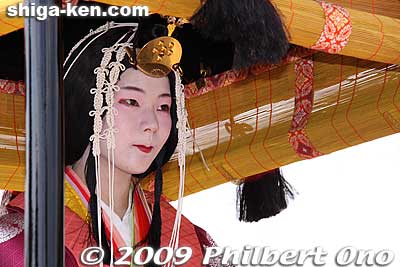
| 
|
| Saio princess | Tsuchiyama Saio Gunko |
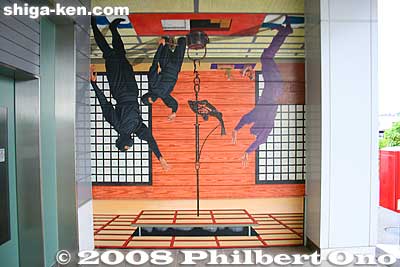
| 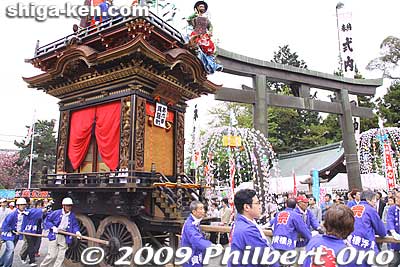
|
| JR Koka Station | Minakuchi Hikiyama Matsuri |
More photos at Koka Photos.
Videos
Click on the video image to start playing the video. More Shiga videos here.
History
- 2004
- Oct.: City founded upon the merger of Koka-cho, Minakuchi-cho, Shigaraki-cho, Tsuchiyama-cho, and Konan-cho towns.
- 2008
- Feb. 23: A 50-km section between Kameyama (Mie Pref.) and Otsu (Kusatsu Tanakami Interchange 草津田上インターチェンジ) of the New Meishin Expressway 新名神高速道路 opens to traffic. A ceremony was held at the Koka-Tsuchiyama Interchange with the Governors of Shiga and Mie in attendance. Passing though Koka and Otsu, the new expressway is expected to lessen traffic on the old Meishin Expressway between Nagoya and Kobe, shorten the driving time to the Kansai area, and bring more visitors to Koka.
- Mar. 29: Japan's first Ninja Certification Exam (Ninja Kentei 忍者検定) is held in Konan-cho, Koka, the ancestral home of the Koga (Koka) ninja and home to Japan's sole remaining original Ninja house. It is a beginner-level written exam with 50 multiple-choice questions. To pass the exam, 30 questions must be answered correctly within 30 min. The questions cover Koga ninja history, ninjutsu techniques, weapons, tools, famous ninja, and ninja in pop culture such as manga and anime. The certification does not include any physical exam of ninja techniques (throwing shuriken star knives, etc.). The exam is held by the Konan-cho Tourist Association to attract ninja fans to Koka. Some 100 ninja fans from all over Japan came to Koka to take the exam. It cost 500 yen to take the exam open to 5th grade students and older people. The top six scorers were awarded with a helicopter ride over Koka after the exam. All the exam takers were treated to a ninja stew for lunch. The exam will be held annually.
Miscellaneous
Recent Koka News and Weather
The latest five headlines for Koka from Shiga News are displayed below. Click to view the latest stories.
Tanuki genitals (Shigaraki-yaki), The Japan Times, July 15, 2008
The last of the ninja, The Japan Times, Oct. 27, 2007
Female potter smashes tradition (Kiyoko Koyama), The Japan Times, Jan. 19, 2005
Creating a museum as a sacred, powerful place (Miho Museum), The Japan Times, July 27, 2002
Trivia
- See how those ubiquitous tanuki raccoon dog statues are made in Shigaraki at Maruichi. Photos show each step.
- Koka was home to one of Japan's two ninja schools. Ironically, Koga ninjutsu is no longer practiced in Koka. It is not considered as a martial art like karate or judo. The other is in Iga-Ueno in neighboring Mie Prefecture.
- By 2008, about 2.8 million tourists visit Koka annually. About half of them visit Shigaraki, the city's most popular tourist destination. During Jan.-June 2008, 750,000 tourists visited Shigaraki, followed by 330,000 visiting Tsuchiyama. The least visited area was Konan-cho, ancestral home of the Koka ninja. Only 80,000 bothered to drop by.
- An area and train station in Koka known as Kounan 甲南 (also spelled Konan) is easily confused with Koka's neighboring city of Konan 湖南.
Famous People
- Lastname firstname
- Description
Side Trips
Other sights in neighboring cities/towns within easy reach from Koka.
- Iga, Mie Pref. - Tsuge Station is just one train stop away on the Kusatsu Line.
- Kusatsu - Stage town and lotus flowers in July.
Related Articles
- Shiga Prefecture
- Shiga Prefecture Sights
- Shiga Prefecture Transportation
- Shiga Prefecture Municipalities
External Links
| Municipalities of Shiga Prefecture 滋賀県 | ||
| Cities & Towns: Aisho-cho | Higashi-Omi | Hikone | Hino-cho | Koka | Konan | Kora-cho | Kusatsu | Maibara | Moriyama | Nagahama | Omi-Hachiman | Otsu | Ritto | Ryuo-cho | Taga-cho | Takashima | Toyosato-cho | Yasu | ||
| 愛荘町 | 東近江市 | 彦根市 | 日野町 | 甲賀市 | 湖南市 | 甲良町 | 草津市 | 米原市 | 守山市 | 長浜市 | 近江八幡市 | 大津市 | 栗東市 | 竜王町 | 多賀町 | 高島市 | 豊郷町 | 野洲市 | ||
| Prefectures of Japan | ||
| Aichi | Akita | Aomori | Chiba | Ehime | Fukui | Fukuoka | Fukushima | Gifu | Gunma | Hiroshima | Hokkaido | Hyogo | Ibaraki | Ishikawa | Iwate | Kagawa | Kagoshima | Kanagawa | Kochi | Kumamoto | Kyoto | Mie | Miyagi | Miyazaki | Nagano | Nagasaki | Nara | Niigata | Oita | Okayama | Okinawa | Osaka | Saga | Saitama | Shiga | Shimane | Shizuoka | Tochigi | Tokushima | Tokyo | Tottori | Toyama | Wakayama | Yamagata | Yamaguchi | Yamanashi | ||
